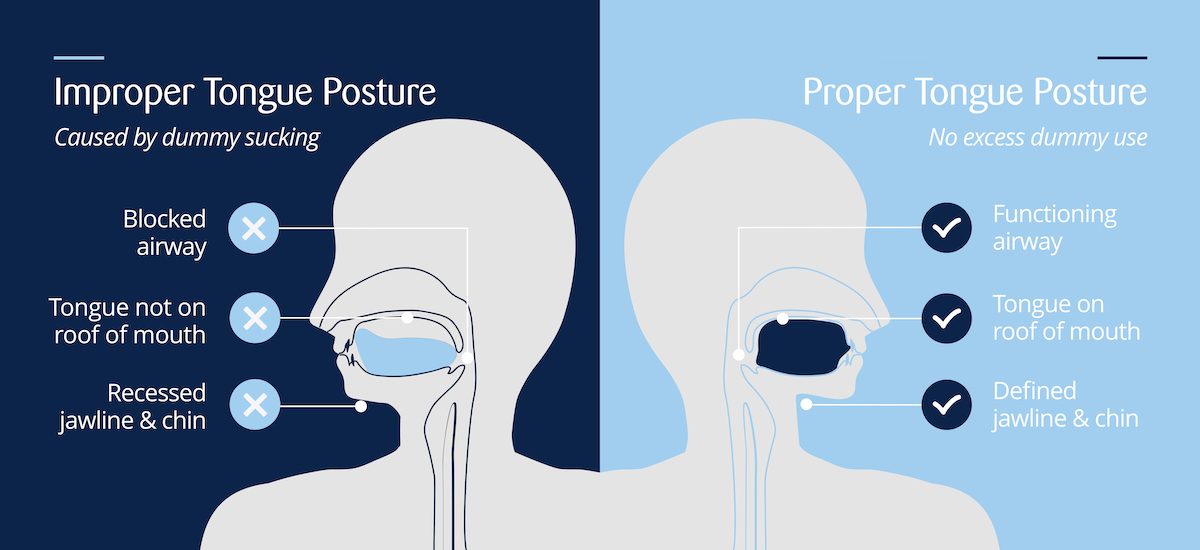Dummy Teeth and Pacifier Teeth - How the Use of Dummies/Pacifiers Can Damage Teeth
As we’ve discussed in previous articles, the keys to ensuring proper facial development in children are as follows:
-
Proper tongue
posture
- tongue sitting on the roof of the mouth
- Proper swallow pattern
- Strengthening jaw muscles via chewing
- Breathing through the nose (not through the mouth)
One of the biggest influences on facial growth and development is dummy or pacifier use. Excessive use of a dummy
or pacifier can lead to what is colloquially known as ‘dummy teeth’ or ‘pacifier teeth’. These terms typically
refer to developmental issues like overbites, open bites and buck
teeth.

Tongue Posture: What is Proper Tongue Posture, and Why is it so Important?
The tongue is the strongest muscle in the mouth, and its position in the mouth dictates how the face forms. How the face forms dictates how the teeth sit within the face...

Overbite: What Causes an Overbite and What is the Best Way to Correct it?
An overbite is symptomatic of unfavourable development of the jaws, whereby the lower jaw fails to grow properly - meaning it is positioned further back in the face...
How Does Dummy Use Affect the Teeth?
The issue with dummies and pacifiers is that they can disrupt tongue posture, swallow patterns and jaw muscles.
Thus, they increase the likelihood of improper facial growth and development, and ultimately, ‘dummy teeth’. When
a dummy is in a child’s mouth, it does several things.
- It forces the tongue off the roof of the mouth - creating a low tongue, open mouth posture.
- A low tongue, open mouth posture forces the lower jaw down and backwards.
-
As it is positioned behind the top teeth, the dummy places a light pressure on the top teeth, which forces them to flare outwards.
These are the primary catalysts for improper facial development. When children maintain these postures and endure
the pressures of a dummy for prolonged periods, they are far more likely to suffer the following:

What Do Pacifier Teeth Look Like - Some Examples
Pacifier teeth will typically take on the characteristics of any of the above conditions (overbite, buck teeth or TMJ dysfunction). Generally, the jaws will tend to grow downward (as opposed to forward), which causes a narrowing of the jaws and subsequent crowding/misalignment of the teeth.
How to Fix Dummy and Pacifier Teeth
As is true of anything related to facial growth and development, prevention is always better than treatment for dummy and pacifier teeth.
It is important for parents to understand that dummies are not designed to benefit the child, but to benefit the parents (by keeping the child quiet). Ultimately, it is best for parents to completely avoid dummy use if they can, however, the reality is that this may be hard for many parents. The second best option is to limit dummy use and finish dummy use by 7 months of age (which is when the child's baby teeth start to come in). If the child ceases using a dummy by 7 months of age, they will generally be able to avoid dummy teeth in the future - assuming they maintain proper mouth posture where the tongue sits on the roof of the mouth.
Where dummy use continues beyond 7 months of age, developmental issues can arise and become much harder to reverse. This is because the jaw bones become less malleable with age.
Will Pacifier Teeth Fix Themselves?
Pacifier teeth are the result of improper facial posture. Thus, the best way to rectify pacifier teeth is by correcting facial posture. Often, this will not occur without orthotropic or orthodontic intervention. So no, pacifier teeth will not normally fox themselves.

Orthotropics: A Better Way to Treat Your Child’s Crowded Teeth
Orthotropic treatment is an early prevention, interceptive, non-extraction, and non-surgical orthodontic treatment dealing with correct growth of the face and jaws...
What if Your Child Suffers From Dummy Teeth?
If your child suffers from dummy teeth, the best treatment method is usually orthotropics. The objective of orthotropics is to correct facial posture by improving tongue posture, swallow patterns, strengthening the jaw muscles and promoting proper breathing through the nose. When treating dummy teeth, the main objective is to ensure the tongue is positioned on the roof of the mouth and the mouth is closed at rest. This encourages the jaws to grow forward and allows the tongue to place light pressure on the teeth, ensuring enough space for them to be properly positioned.
The Benefits of Using Orthotropics to Treat Dummy Teeth
The main benefit of orthotropic treatment is that it treats the cause rather than the symptoms. By contrast, traditional orthodontics tends to target the symptoms of dummy teeth. Braces are commonly used to force the teeth into alignment. However, this does nothing towards correcting the underlying issue, which is a low tongue, open mouth posture. Without fixing this, there is often little longevity to treatment.
Instead, orthotropics uses removable orthopaedic appliances. Their intention is not to shift the teeth but rather
promote proper posture. This approach also reduces the risk of TMJ dysfunction and other flaw-related issues in
the future. You can learn more about the benefits of orthotropics here.


